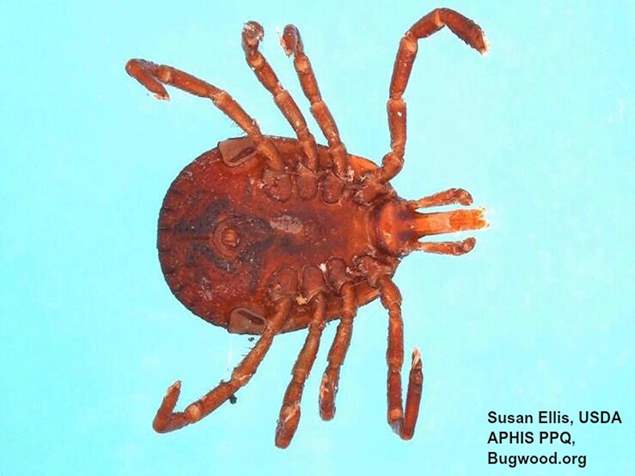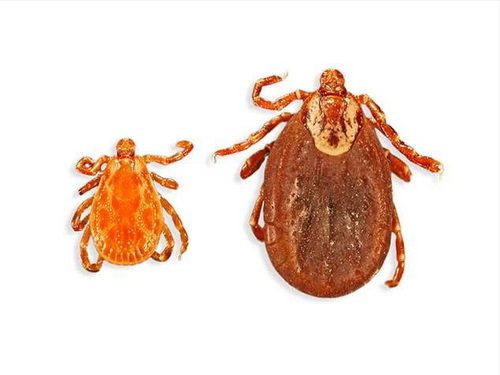
Fleas and ticks are small, bloodsucking parasites that can annoy both pets and people and transmit serious diseases such as Lyme’s disease and Rocky Mountain Spotted Fever. They are are very common pests here in Missouri, where our climate promotes the growth of tall grasses and heavily wooded areas which fleas and ticks thrive in.
Fleas
The most common species in Missouri is the cat flea, but we also occasionally encounter the dog, human and oriental rat flea. Several pathogens may be transmitted by the bite of these pests. Plague and typhus continue to be a threat to human populations in the United States. Just like in the middle ages, rodent populations serve as the reservoir for plague-causing organisms and several flea species transfer the disease to humans. These pests aren’t just annoyances at your neighborhood BBQ or sources of bother for your pets, they’re also a serious threat to your health and well-being. Being proactive is important. Take steps to control these pests before they become a problem and enjoy a worry free summer and fall with our guaranteed maintenance program.
Ticks
The two most frequently encountered ticks in Missouri are the lone star tick and the American dog tick. Another species, the brown dog tick, may also be common on domestic dogs. The brown dog tick only feeds on dogs but may be brought into homes with dogs and become an indoor pest. It’s very important to promptly remove a tick from the skin at first sight. Remove a tick using tweezers, grasping the tick as close to the skin as possible and pull with steady, even pressure. Do not crush the tick as this may leave the head embedded in your skin. After removal wash the area with soap and water and, if possible, sanitize with rubbing alcohol.


Contact a veterinarian to get the appropriate preventative medicines for your pets, and call Crosshair Pest Control to treat your yard. The cost for monthly prevention is certainly less expensive than the cost of eliminating an infestation, the risk of health problems to you and your pet and unsightly and uncomfortable bites on your ankles! Our knowledgeable, licensed and insured technicians can diagnose your particular situation and provide a safe and effective protocol using integrated pest management principles to remove natural attractants for these pests and if necessary, apply a chemical barrier to keep them away.
Before your flea treatment
Although vacuuming will not remove all fleas, eggs and larvae, you should vacuum weekly to remove as many of them as possible. Areas that require special attention include pet resting areas, carpets, around legs of furniture that pets rub against, cracks and crevices along baseboards, upholstered furniture if the pets are allowed on such furniture, and under beds if the pets are allowed on them. Be sure to carefully and thoroughly vacuum and wash any area that will not receive chemical treatment.
- Vacuum the entire house — especially areas visited frequently by pets.
- Remove the vacuum bag.
- Place it in a sealed plastic bag
- Dispose in outside trash container.
Why Choose Our Services ?
Our technicians are licensed, insured, bonded, and highly qualified to deal with any problem in your home or business. We will restore your home to a clean, sanitary, and safe living environment and help you maintain that condition. We’ve been providing pest control services in the Columbia area for over 40 years, and our iron-clad guarantee means that relief from noxious pests is never more than a phone call away. Contact us today!
Frequently Asked Questions
Can fleas live on humans?Fleas will feed on you when they have an opportunity, but they won’t live on you. They much prefer to live on our furry friends.
How do I get rid of a flea infestation in my house fast?
Vacuum as described above, clean and dry all your bedding and linens (flea-bitten or not) on a high heat setting, and call Crosshair Pest Control to eradicate the population in all areas of your home.
What do fleas look like?
We show you a picture above, but to anyone with normal vision what you will see are small wingless and dark insects with a hard carapace. If you notice itchy red dots along your shins, ankles, and feet you probably need to call us ASAP.
How contagious are fleas?
Fleas ARE contagious, but not in the way most people think. Adult fleas generally won’t leave a host once they’re embedded, but spread by dropping flea eggs in their environment (including carpeting), the eggs hatch and the new generation finds their own host. It takes very little time for fleas to spread from animal to animal.
Houseman, Richard M. “Fleas and Ticks.” https://extension.missouri.edu/publications/g7382
“Ticks.” PestWorld, https://www.pestworld.org/pest-guide/ticks